Upstox Originals
How India spends its time: Insights for investors
.png)
6 min read | Updated on May 06, 2025, 14:25 IST
SUMMARY
India’s 2024 Time Use Survey reveals a powerful truth: While we all get the same 1,440 minutes a day, how we use them varies widely across gender, region, and occupation. This article breaks down how men and women, rural and urban Indians, spend their time, and what these patterns reveal about our workforce, unpaid labour, and where we’re headed as a society and economy.
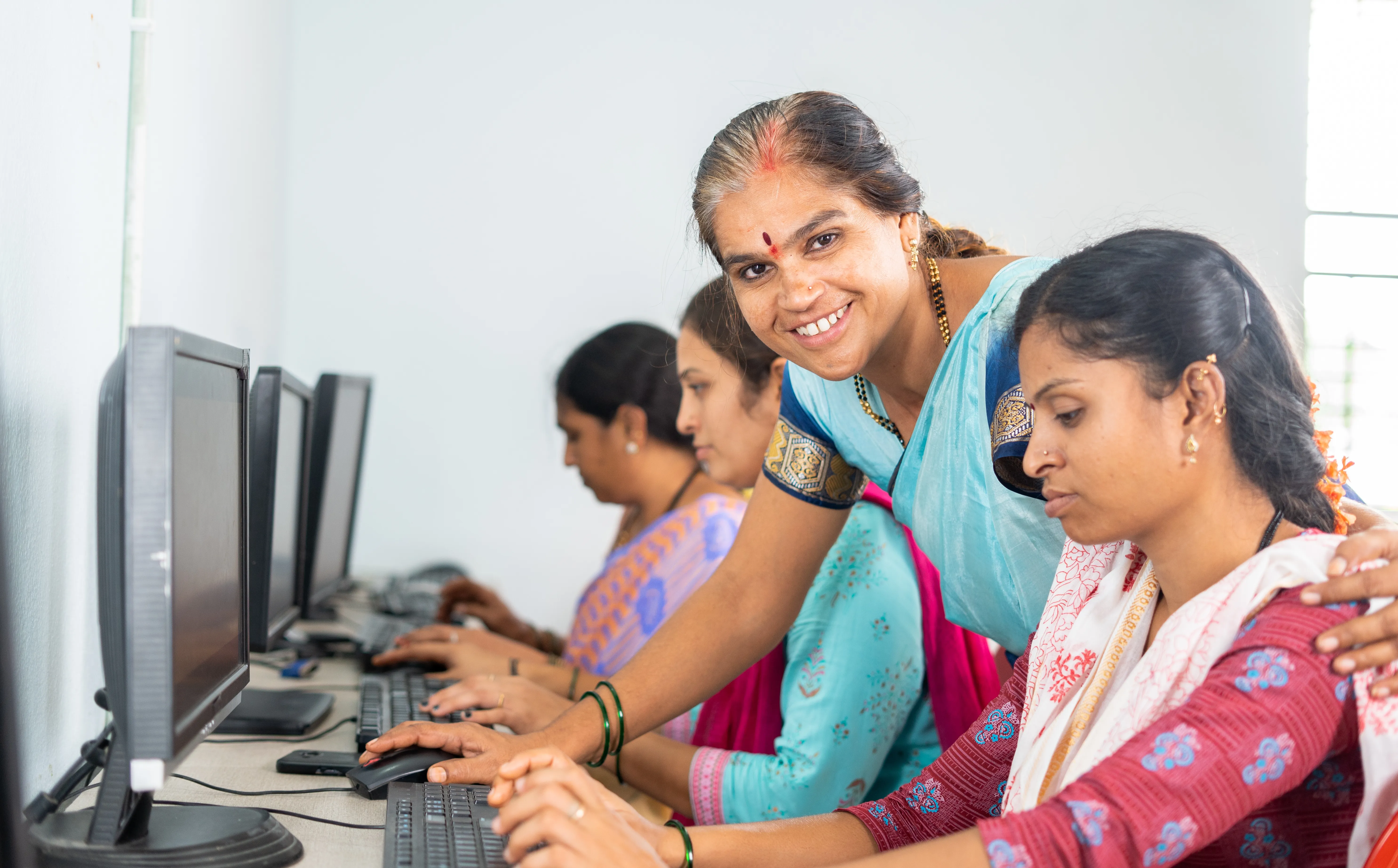
Indians are spending more of their time on work and leisure activities.
Time is the ultimate equaliser—every Indian, from a schoolkid, to a farmer, a labourer or a white collared professional, gets 1,440 minutes in a day.
But how we spend those minutes reveals much more than just routine. It reveals opportunity. The Time Use Survey 2024 gives us a closer look at this. And while headlines often focus on what’s missing, there’s a more powerful story hiding in plain sight: India’s workforce is evolving, and the time we are not yet using for formal work represents a once-in-a-generation opportunity.
Imagine we ask 100 people what they did yesterday. If 50 of them say they worked for pay, the participation rate for employment is 50%. It’s not about having a job in general, but about whether someone did that activity on that specific day.
Going by the same participation rate, this is what the data of 1.39 lakh households or 4.54 lakh people tells us.
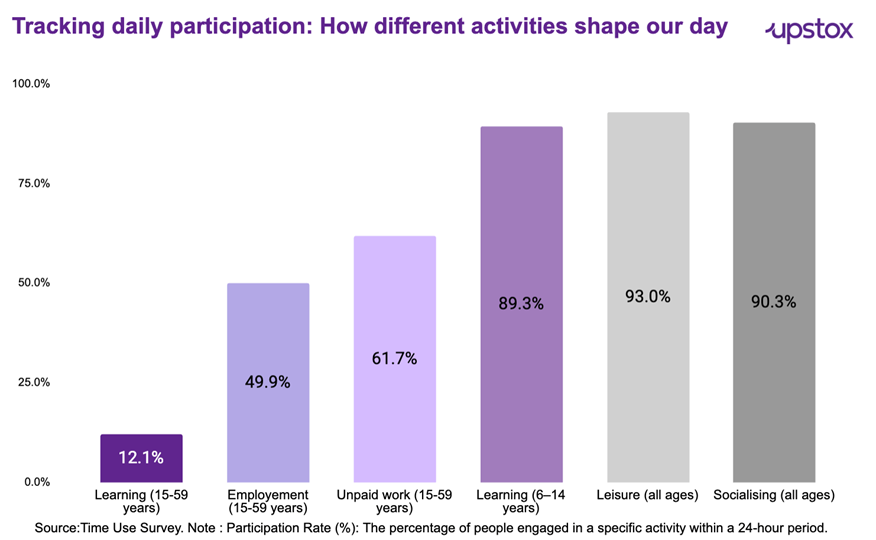
-
Employment: Only 49.9% of Indians aged 15–59 (the core working-age population) participate in employment-related activities on any given day. This means more than half of India’s prime working population is not engaged in formal employment daily. Interestingly, the participation rate is higher in unpaid work than in employment-related activities for the working-age population.
-
Social and leisure: Even though 50% of the working-age population participates in employment, almost all Indians engage in leisure and social activity, where the participation rate is around 90-93%.
-
Learning: 89.3% of children (6–14 years) are engaged in learning on a typical day. But this drops steeply to 29.5% for the 15–29 age group and further to just 12.1% for working-age adults (15–59 years). The sharp decline in post-school years suggests a limited culture of adult reskilling or lifelong learning, especially in an era of rapid digital and economic shifts.
This unused workforce isn’t a problem. It’s a massive opportunity. If more of these individuals enter paid jobs, India could:
- Unlock greater productivity
- Improve household incomes
- Boost its GDP in a big way
Workforce participation: Gender Wise comparison
Women spend over 21% of their day on unpaid activities like caregiving and household work, compared to just 3.9% for men. On the other hand, men currently dominate paid work, contributing 17.4% of their day, versus 4.3% for women. The future obviously lies in enabling both men and women to share the load—and the opportunity.
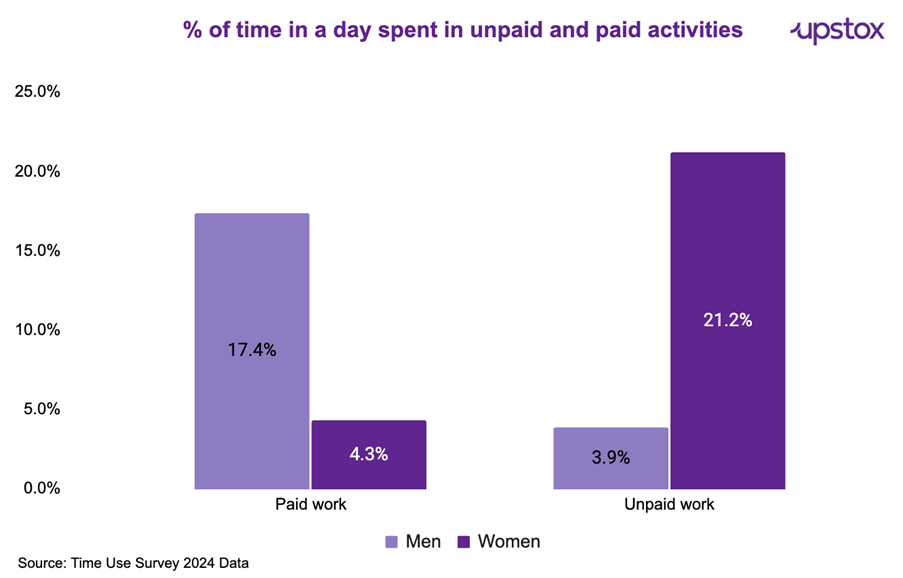
How do rural vs urban India spend the day?
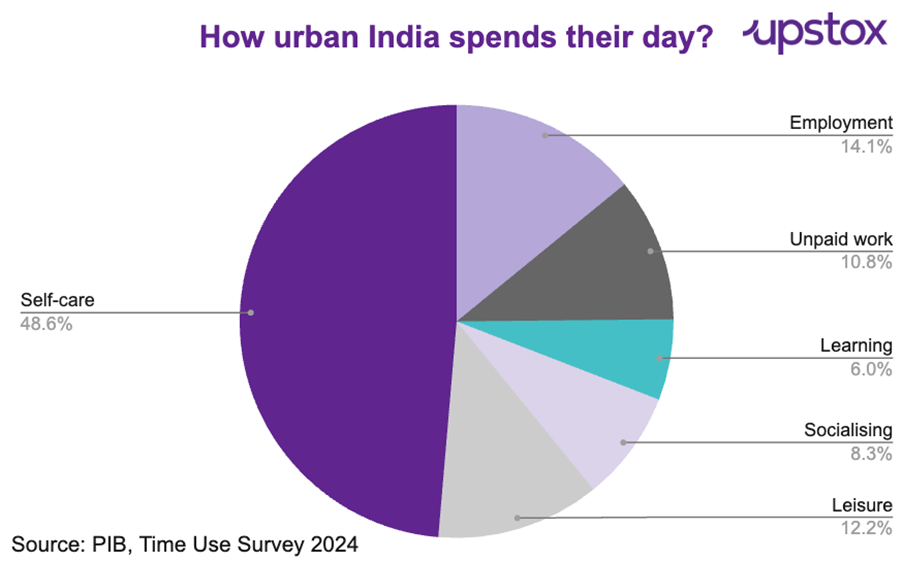
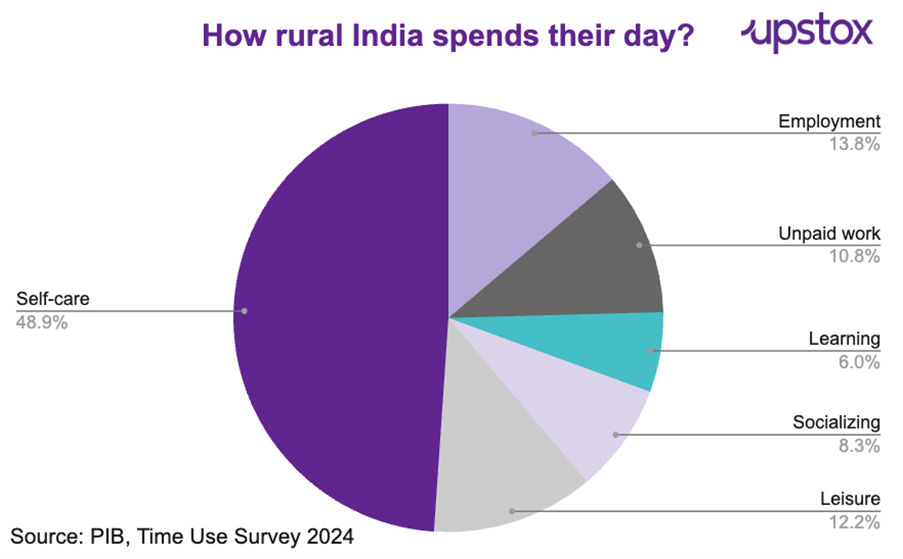
How India spends its day: 2019 vs. 2024
The 2019–2024 Time Use Survey comparison reveals an encouraging shift in how Indians are spending their day—with more time being allocated to productive and enriching activities. Time spent on employment has increased by 16 minutes, indicating stronger workforce participation and a positive trend in economic engagement. Leisure activities, too, have grown by 16 minutes, suggesting a healthier work-life balance and rising access to entertainment and recreation across age groups and regions.
Even unpaid work, though marginally higher by just 1 minute, reflects consistent societal contribution, especially in caregiving and domestic roles. While time spent on learning and social interaction has dipped slightly, this could point to evolving modes of informal learning and virtual community engagement.
A notable decline of 24 minutes in self-care and maintenance suggests improved efficiencies in daily routines, possibly due to better infrastructure or time-saving tools. Overall, the data highlights how India is moving towards a more balanced, economically active, and personally fulfilling daily life.
| Activity | TUS 2019 (Total) | TUS 2024 (Total) | Comparison |
|---|---|---|---|
| Employment and related activities | 164 | 180 | 16 |
| Unpaid work | 158 | 159 | 1 |
| Learning | 93 | 89 | -4 |
| Social | 130 | 125 | -5 |
| Leisure | 143 | 159 | 16 |
| Self-care and maintenance | 752 | 728 | -24 |
Source: PIB, Time Use Survey 2024
What does a user survey mean for investors?
| Sector | Key insights |
|---|---|
| Consumer appliances | As women begin shifting more time toward paid work, there is a growing demand for time-saving tools like washing machines, dishwashers, and kitchen appliances. This is especially relevant in dual-income households and among upwardly mobile consumers. |
| EdTech & skilling | Time spent on learning has declined across age groups, particularly post-school. This indicates a large pool of individuals could benefit from flexible, mobile-based skilling and vocational education to improve employability. |
| Elder & childcare services | Over 34% of women and 18% of men engage in caregiving. With the rise of nuclear families, urban migration, and ageing parents, formal elder care, childcare centres, and home nursing services can ease household caregiving responsibilities. |
| Digital entertainment & gaming | Near-universal media consumption and rising smartphone use make India a fertile ground for OTT platforms, mobile gaming, and short-form or multitasking-friendly content. |
| Ready-to-eat FMCG & kitchen tech | The slow decline in women's housework time despite increasing labour participation shows the dual burden they carry. This creates a strong market for quick-cooked foods, food delivery services, and automated kitchen solutions, particularly for time-poor, working women in both urban and rural India. |
| Women workforce platforms | There is a growing demand for flexible, part-time, or remote work platforms, financial products tailored to women, and services that facilitate entry into paid work. |
| Health & wellness | With self-care time stable, but greater awareness about health and fitness, there is strong potential for online fitness classes, wellness apps, nutrition brands, and hybrid fitness studios catering to both men's and women’s evolving health routines. |
Conclusion: Turning minutes into markets
India’s time-use patterns are not just a reflection of habits—they are a mirror of the nation’s structural gaps and emerging aspirations. The widening access to paid work for women, a stable caregiving burden, and near-universal media usage highlight where the economy is headed. For investors, the opportunity lies in creating solutions that save time, increase productivity, and redistribute invisible labour. Whether it is building flexible learning for youth, designing appliances that lighten domestic loads, or launching on-demand eldercare services, the Indian consumer is signalling readiness for products that make daily life more efficient.
As time becomes the new currency in Indian households, those who help people reclaim it could be the biggest beneficiaries of this next wave of economic transformation.
About The Author
Next Story
